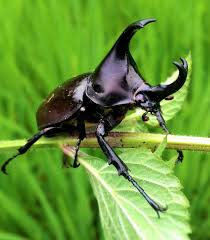Most above ground swimming pools sit directly on the earth. And the earth is a dynamic environment with all kinds of things living in it. Horned nose beetles are one of those things.

Horned-nose or rhinoceros beetles are just like other brown beetles, except they have horns that stick out of their heads just like a rhinoceros. These horns have very sharp points that can easily poke though an above ground pool liner.
HOW CAN I TELL IF I HAVE HORNED NOSE BEETLES IN MY YARD?
Horned nose or rhinoceros beetles are usually fairly visible in yards. They don’t glow, make any audible noise, make visible homes, or anything like that. But they can be easily seen walking along the top of the ground.
This rhinoceros beetle is in the scarab beetle family, which means as little to me as it probably does to you. I bring this up though, because there may be some beetles living in your yard that look exactly like a horned nose beetle, except it doesn’t have any liner penetrating horns.
Here in Central Florida where I install above ground pools, most of the beetles I see in yards do not have horns, which is great. They cannot poke holes in the liner if they find themselves under the pool. They can make tiny troughs as they travel under the liner, but that’s about it.
Horned nose beetles live in most southern and eastern areas of the US. According to the National Wildlife Federation , these horned bugs live south of Arizona, northeast to Nebraska, and then south and east of that.
I HAVE SOMETHING SHARP UNDER MY POOL LINER. HOW CAN I TELL IF IT’S A RHINOCEROS BEETLE?
Unfortunately, the feel of a rhinoceros beetle’s horn/s poking against a pool liner feels a lot like other common things that are left under an above ground pool. A beetle horn is very sharp, so it can feel exactly like a small root poking upward, a piece of glass, the beginning of nutgrass trying to come through, a piece of wire, or small construction trash in the ground.
MY RHINO BEETLE STORY
About twenty-five years ago, I was installing above ground pools for a company called “Hawaiian Pools”. They were a rip-off company that sold above grounds for many thousands more than they were worth. They secured me as their installer for Central Florida and paid me above fifty percent more than I charged, so it was a good deal for me. When I found out how awful they were at overcharging homeowners for pools, I stopped installing for them.
During that time, I got a call from Hawaiian stating that one of the pools I installed had something sharp under the liner and that I needed to go and check it out. When I called the homeowner to set up a time to come out, he was entirely indignant.
He expressed to me how unhappy he was with the job I did and how he wanted it completely fixed with a new liner. When I asked him to list the issues, it really only came down to the sharp thing poking through his liner. He tried to add some other issues with the install but was not able to as I had done an excellent job.
At this point of installing pools for Hawaiian, I was fairly used to people not being happy. I was sure that his real issue with me was when he found out he spent 15k for a two thousand dollar pool and couldn’t get out of the deal.
Anyway, I go out to his pool, get in it, and investigate his sharp object. In person, the homeowner was less belligerent but still angry and was just waiting for me to admit some fault. When I went down in the water and found the bad spot, I was worried. It felt like a piece of wire and it had poked through the liner. I tried to push it down, but it wouldn’t go down and felt “springy” like it was a wire.
The install site did have some construction trash from when the house was built and I was careful to get it all out of the earth, but you never know if you get it all. I was worried that it was a wire because that would’ve been my fault and my worst-case scenario was having to drain the pool and replace the liner at my cost.
I got out of the pool and retrieved a pair of needle-nose pliers to see if I could pull the wire out and then repair the liner and be done. As I pulled the wire upward, it wouldn’t come out and seemed like it was attached to something bigger. This was a bad sign for me as I thought of my future of having to work a day for free while buying a new liner all at the attention of an angry customer.
I made the hole in the liner a little bigger to make room for pulling out the wire and then out came a rhinoceros beetle.
It felt good to come up out of the water holding a rhino beetle instead of a piece of wire. I showed it to the onlooking homeowner and stated what it was, that this was unavoidable, and was not my fault. It was considered an “act of God” or some terminology like that in the contract he signed.
The homeowner had been such an asshole to me but suddenly had no grounds to be. I was not happy with the way that I had been treated and considered charging him for this removal and repair of his liner. I didn’t though as I felt sorry for him. It might have cost me an hour or so of drive and repair time, but that was nothing compared to the years of payments he was going to pay for something he got sold into buying for 5000 percent more than its value.
Moral of this story: Treat people with respect at least until you can verify that they made a mistake.
THE ONLY WAY I KNOW IF IT’S A HORNED NOSE BEETLE
As mentioned above, the puncture from a beetle’s horn can feel and look like most common things under liners. But there is one way to tell if it’s a rhino beetle and nothing else. Most horned nose beetles will have three horns that can make holes in a liner. And those horns are in a triangle pattern.
If you go down into the pool and find three small holes in a triangle pattern, it’s most likely a rhinoceros beetle under the liner. This isn’t always the case as some rhino beetles will have only one or two horns instead of three.
HOW TO REPAIR AN ABOVE GROUND POOL LINER DAMAGED BY A HORNED NOSE BEETLE
There are two ways to fix an issue with a rhinoceros beetle under the pool liner.
Tree hugger’s method (not recommended)
I’ve been doing yoga for nineteen years now. Because of this, I now have a lot of friends that don’t want to kill anything no matter what. That’s cool. Be you.
If you are the type that catches roaches or spiders in the house so you can gently let them out, or shoo away a mosquito while it’s biting you instead of smashing it into a bloody oblivion against your skin, then you should know this:
“The rhinoceros beetle trapped under your pool poking its horns through the liner has almost assuredly already passed away”
If you are in the hopes of thinking that it may still be alive, then you can go down in the pool and make a small cut in the liner right where the horns are. Don’t worry about cutting the beetle. He/she has a very hard top shell.
After making as small a cut as you can, pull out the beetle either with your fingers or a pair of needle-nose pliers. Take him to the top and out of the water and see if it moves.
If it starts moving, congratulations, you saved a beetle. He can now live out the rest of his long life(probably a couple of months max) regaling other beetles with his fantastic story of survival.
Don’t forget to go back down in your pool and repair the cut liner with an underwater patch kit. That’ll be the easy part.
Mouth breather’s method (recommended)
Knowing that it’s probably already dead and/or not caring about the remaining life of a common bug, you may proceed easily fixing this issue.
Using a hammer (and maybe a small piece of wood), go down in the water and find the area where the rhino beetle is. Feel where the horns are and feel where the rest of the body of the beetle may be under the liner.
Gently tap the beetle and his horns down flat into the floor of the pool. Continue to tap the area until you cannot feel the horns or the beetle as it will be hammered down into the earth.
Very closely inspect the area to see if any holes were made by the horns or by your tapping down on them. Repair any holes by using an underwater patch kit and you’re done. The bottom will now be flat and you may not even be able to tell where the bug was (or still is).
HOW TO PREVENT RHINOCEROS BEETLES FROM TRAVELING UNDER YOUR ABOVE GROUND SWIMMING POOL
There is no certain way that I know of that will prevent horned nose beetles from going under your pool. There are insecticides that some farmers use to control them, and there are traps you can buy to extract them too. I don’t think these methods are worth it just to protect your pool bottom from rhino beetles though.
Allowing chickens to roam in your yard periodically would probably work very well with these beetles, but you have to have chickens for that.
Purchasing and installing a liner pad/guard will usually stop the horns from going through the liner, but I have seen them go through the pad and the liner, so it’s not a 100 percent guarantee. A foam board bottom or a happy bottom will prevent them for sure.
I will say that rhino beetles usually penetrate an above ground pool liner within the first month that the pool is installed, so it’s not usually an ongoing problem. So, if you have one that gets trapped under your pool liner, don’t stress. Just fix it and you most likely won’t have another one. Most likely.
